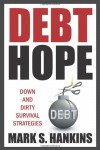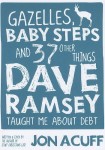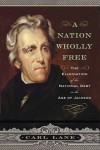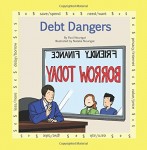Top Rated Videos
The official e-book of the Debtors’ Revolution. Revised and updated with 140+ pages of inside information and actionable strategies. 214 footnotes and other references hyperlinked to source material on the web. Ann Minch says “You Need This Book!”
Insider Secrets in my book:
* How creditors improperly use certain forms of leverage to try to collect from you long after they are legally allowed to.
* How collectors can get their names on your credit reports even when they are no longer allowed to have information listed there.
* Dirty tricks creditors use to get around the statute of limitations.
* Why using the statute of limitations to defend against a creditor should be the last resort.
* Why paying a collector everything they want doesn’t guarantee you won’t be returned to for the same debt again and again-and what to do about it.
* How collectors try to “manufacture” proof you owe them a debt.
* Why past trouble with a bank account means you must be extremely careful who you order checks from.
* Why you may not be in the clear even after a judgment against you has expired.
* Which states turn public officials trying to help a creditor collect from you into a profit center by giving them a percentage.
* Why depositing a $1.55 check can cost you everything in your bank account.
* Debtor’s prison is a relic of history-or is it?
* Which states’ judgments continue carrying whatever outrageous interest the creditor was charging you.
* How a creditor can file bankruptcy for you-and why they’re wary of doing it.
* What to do after you pay a judgment, and why you may want to delay doing it.
* Credit card offers you should never, ever accept.
* How turning eighteen can put you suddenly deep into debt.
* Why your parent’s nursing home stay can mean you owe debt you never signed for.
* You’ve been foreclosed on … now you owe a mortgage deficiency … or do you?
* How to research a collector who is trying to collect from you so that you know their weak points.
* How to settle a debt … even when the other side hasn’t agreed to it.
* Why some debts can never be sued on, while others have a shorter statute of limitations than you would otherwise think.
* Which kinds of businesses aren’t going to help you at all with your debt problems.
* The obsolete trick to avoiding debt problems that can get you branded a terrorist.
* How one of the country’s biggest collectors tried and failed to outsmart his own industry-with deadly consequences.
* Why banking out of the country can be disastrous and where you can safely bank in the country.
* How creditors illegally scrawl on bankruptcy’s “clean slate.”
The American middle class is being destroyed by credit card debt. As of December 2009 we are looking at 11% or better chargeoff rates overall through Summer 2010 according to Moody’s and Fitch. Debtors need to know how to get through the pandemic of ratejacking and fee harvesting that the major credit card banks are using to shore up their sagging balance sheets. If you can’t pay, you need to know what’s coming and how to handle it. Bankruptcy is harder to use and provides less relief than it once did. To protect yourself and your family when you have defaulted debt in your life you need to understand who you’re going to come in contact with and how to handle them.
Where other books are 90% polemic and 10% practical solutions, this book provides key information regarding the industry, its tricks, traps and vulnerabilities. It’s what you need to know before you head into the rapids.
Product Features
- Used Book in Good Condition
It is commonplace to say that criminals pay their debt to society by spending time in prison, but what is a “debt to society”? How is crime understood as a debt? How has time become the equivalent for crime? And how does criminal debt relate to the kind of debt held by consumers and university students?
In Debt to Society, Miranda Joseph explores modes of accounting as they are used to create, sustain, or transform social relations. Envisioning accounting broadly to include financial accounting, managerial accounting of costs and performance, and the calculation of “debts to society” owed by criminals, Joseph argues that accounting technologies have a powerful effect on social dynamics by attributing credits and debts. From sovereign bonds and securitized credit card debt to student debt and mortgages, there is no doubt that debt and accounting structure our lives.
Exploring central components of neoliberalism (and neoliberalism in crisis) from incarceration to personal finance and university management, Debt to Society exposes the uneven distribution of accountability within our society. Joseph demonstrates how ubiquitous the forces of accounting have become in shaping all aspects of our lives, proposing that we appropriate accounting and offer alternative accounts to turn the present toward a more widely shared well-being.
Jon Acuff’s hilarious thoughts on all things Dave Ramsey. Perfect for the Dave fan who has everything, or the person who wants to laugh about money while on their journey to financial peace.
Product Features
- ISBN13: 9780978562090
- Condition: New
- Notes: BRAND NEW FROM PUBLISHER! 100% Satisfaction Guarantee. Tracking provided on most orders. Buy with Confidence! Millions of books sold!
The Last and Only Time America Was Free of Debt?and How It Led to the Two-Party Political System
?An engaging treatment of a topic of perennial concern and frequent misunderstanding, this lucid tale of the brief moment when the United States was debt-free should be on every Congress member’s bedside table.”?Peter J.Woolley, Professor of Comparative Politics, Fairleigh Dickinson University
When President James Monroe announced in his 1824 message to Congress that, barring an emergency, the large public debt inherited from the War for Independence, the Louisiana Purchase, and the War of 1812 would be extinguished on January 1, 1835, Congress responded by crafting legislation to transform that prediction into reality. Yet John Quincy Adams,Monroe’s successor, seemed not to share the commitment to debt freedom, resulting in the rise of opposition to his administration and his defeat for reelection in the bitter presidential campaign of 1828. The new president, Andrew Jackson, was thoroughly committed to debt freedom, and when it was achieved, it became the only time in American history when the country carried no national debt. In A Nation Wholly Free: The Elimination of the National Debt in the Age of Jackson, award-winning economic historian Carl Lane shows that the great and disparate issues that confronted Jackson, such as internal improvements, the ?war” against the Second Bank of the United States, and the crisis surrounding South Carolina’s refusal to pay federal tariffs, become unified when debt freedom is understood as a core element of Jacksonian Democracy.
The era of debt freedom lasted only two years and ten months. As the government accumulated a surplus, a fully developed opposition party emerged?the beginning of our familiar two-party system?over rancor about how to allocate the newfound money. Not only did government move into an oppositional party system at this time, the debate about the size and role of government distinguished the parties in a pattern that has become familiar to Americans. The partisan debate over national debt and expenditures led to poorly thought out legislation, forcing the government to resume borrowing. As a result, after Jackson left office in 1837, the country fell into a major depression. Today we confront a debt that exceeds $17 trillion. Indeed, we have been borrowing ever since that brief time we freed ourselves from an oversized debt. A thoughtful, engaging account with strong relevance to today, A Nation Wholly Free is the fascinating story of an achievement that now seems fanciful.
Borrowing money is advertised as “easy”. So, why not do it? The truth is, taking out loans can create big problems for kids. Debt Dangers tells a great story about Chelsea and Jack saving money, living within their means, and why kids should avoid debt. A book in the series “Marvels of Money … for kids”; richly illustrated, engaging and practical fictional stories for young readers about the fundamentals of money. This book supports emerging educational (K-5) learning standards for common core, integrating “life skills” and “reasoning skills” into the fictional but realistic financial literacy stories. Each story in the series includes essential financial words, which are highlighted throughout each story and then defined in a glossary along with summary concepts at the end of each story. 3rd-6th grade level readers will find the 2,500 word story and numerical examples great for reading, mathematics, social sciences and financial literacy! Younger (K-2) readers may skim the concepts in a picture book manner, as there are incredible illustrations on each page. Great real-along and discussion books! Messages to last a lifetime.
Before you can control your finances, save money, and get out of debt, you must first understand your spending habits. Sounds simple, right? But for most people it is not, because budgets are based on complicated monthly spending habits, which can be overwhelming, causing people to give up.
Now, there’s a different way that will revolutionize the way you look at personal finance. In an incredibly easy, comprehensible way, The Dollar Code shows you how to break down spending in order to pay off debt and achieve financial freedom–no matter how many other methods have failed you in the past.
Jason R. Hastie’s method is based on the principle of living within your means, but what makes it different is that it gives you just one number to remember—your own personal “Daily Digit”—the amount of money you can freely spend each day without going into debt. This one number is the key to financial freedom because it makes spending easy to understand, and when you understand spending, you can control it.
Who will benefit from reading and applying The Dollar Code? Everyone who has ever identified with one or more of these statements: I can’t understand why I don’t have enough money at the end of the week.
I’ve tried budgeting and failed because it was too complicated. I feel out of control of my finances. I get depressed about not having enough money. I have too much debt and feel like the world is caving in. I feel constantly bombarded by unexpected fees and expenses.Not only does Hastie’s Dollar Code put those statements to rest, it also addresses a broad range of issues and scenarios that sometimes catch us off guard and, if we’re not careful, throw us into a tailspin. Hastie also tackles head-on issues such as the benefits and pitfalls of credit cards, emergency funds, saving for the future, and “the fun bucket.” His handy “twenty tips” and worksheets at the back of the book make applying the dollar code even easier and, once you unlock your code, you’ll understand why it is the one and only number you need to achieve financial freedom. Really—it’s that simple . . . and fun!






